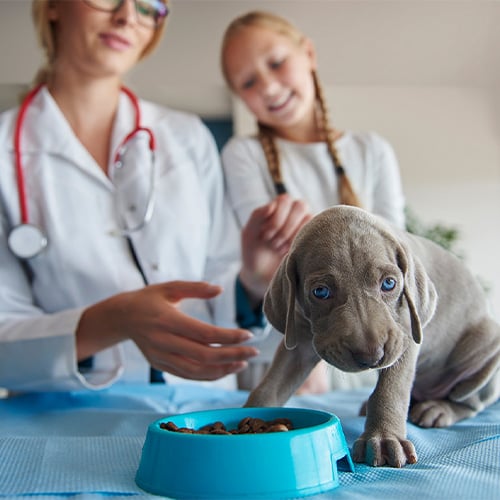Eyes are some of our most sensitive organs on our faces, exposed to all sorts of allergens in the air, and this is no exception for our pets either. To prepare for such occurrences, here are some of the common eye problems in pets that you should take note of:
Corneal wounds and ulcers
The eye has a clear, skin-like tissue covering its surface called the cornea, which allows light to pass through. The cornea can be injured like any other body part, causing cuts, lacerations or even ulcers, causing the affected part to look cloudy. With a corneal wound, your pet may experience eye pain and squint often, leading to redness in their eyes and even discharge.

Photo from wagwalking.com.
Mild corneal wounds can be fixed with antibiotic eye drops or ointments, leaving the cornea to heal with time. However, more severe cases might require surgery or other treatments, so be sure to check with your vet if you suspect your pet to be suffering from problems with their cornea! If left untreated, these wounds and ulcers could lead to permanent blindness and disfigurement.
Cherry eye
Cats and dogs have three eyelids, with the third being home to a tear gland. However, when the ligaments in the eyelid fail and it prolapses, it causes the gland to slip out from its spot and get stuck at the corner of the eye, hence looking like a cherry. This is usually due to the pet’s genetics, where the ligaments in the eyelid are weaker than most.

Photo from purina.co.uk.
If your pet suffers from a cherry eye, a simple surgery would be required to attach the gland back into its original position.
Entropion
Sometimes, your pet’s eyelids will also roll inwards, causing Entropion. This leads to hair rubbing on the surface of the eye, which can result in pain and increased tear production, even damaging the cornea in the process. Similar to cherry eye, Entropion can possibly be a genetic problem too, or a result of constant squinting. Entropion are commonly seen in certain breeds, such as Shar Pei, Bulldog etc.
The eyelid can be temporarily sutured to a normal position by a vet, though in some cases, pets can undergo surgery to permanently fix the abnormal anatomy.
Dry Eye
Dry Eye, or Keratoconjunctivitis Sicca (KCS), occurs when the tear glands in your pet’s eyes produce fewer tears than normal, which can cause the eyes to feel irritating and could even lead to more serious symptoms such as eye pain, corneal ulcers and chronic drainage of mucus from the eyes.
Mild cases can be treated with regular application of artificial tear solutions, similar to human eye drops, as well as medication that can stimulate tear production. If needed, surgery is also an option to redirect a duct that produces saliva to moisten the eyes.
Conjunctivitis
Conjunctivitis, also known as Pink Eye, is caused by the inflammation of mucus membranes in your pet’s eyes called conjunctiva. This causes the conjunctiva to be redden and swollen, as well as other symptoms such as eye drainage and discomfort.

Photo from petcoach.co.
Usually conjunctivitis itself is a symptom of other illnesses and disease, and can also be the result of things such as dust, infections, and allergic reactions. Sterile eye washes can be bought and used to wash out any irritants in the eyes, while bacterial infections can be treated with antibacterial eye drops and ointment. Be sure to properly sanitise your hands before and after handling your dog with conjunctivitis too, so as to prevent the possibility of getting conjunctivitis yourself!
Glaucoma
Glaucoma happens when the production and discharge of fluid in your pet’s eyes is disrupted, causing an imbalance that leads to an increase in pressure within the eyes. Symptoms of glaucoma include pain, red eyes, increased tear production, a visible third eyelid, corneal cloudiness, and dilated pupils. In severe cases, an obviously enlarged eye can also occur.
An immediate visit to the vet should be arranged, as any delay on treatment could lead to possible blindness in your pet. Topical and oral medications will be prescribed to help with the inflammation and balance out the fluids in the eyes, and surgery will be recommended if needed.

Photo from petcoach.co.
Cataracts
When the lens in your pet’s eye starts to get cloudy and opaque, they may be forming cataracts. Located in the middle of the eye, cataracts will block out any light from entering the eye, resulting in poor vision or even blindness in your pets. It is sometimes confused with lenticular sclerosis, which is a natural aging change in older pets’ lenses, but a check with a vet will help to determine which your pet has.
Surgery is available if your pet’s vision is severely compromised by cataracts. However, cats and dogs tend to adapt well to poor vision, as long as they live indoors, so there’s no need for a major fuss.

Photo from wagwalking.com.
Though these problems may be common in some cats, a simple routine check and grooming of your beloved pets can help to search for any symptoms, and ensure that they stay safe and healthy!
References:
https://www.petmd.com/dog/slideshows/8-common-eye-problems-dogs#slide-1
https://www.petmd.com/cat/slideshows/7-common-eye-problems-cats#slide-1

